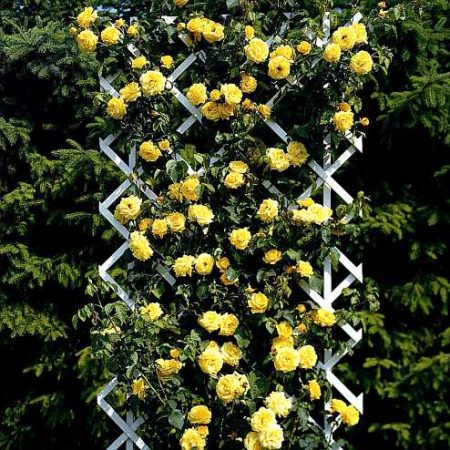 To date, invented a huge number of different decorations and accessories for the garden or cottage. It can be anything and not an exception are support for climbing roses. Undoubtedly, there are many subspecies of this plant. Based on what, the supports themselves differ.
To date, invented a huge number of different decorations and accessories for the garden or cottage. It can be anything and not an exception are support for climbing roses. Undoubtedly, there are many subspecies of this plant. Based on what, the supports themselves differ.
Of course, forged products with various openwork elements are considered to be the most exquisite, but since this is far from a budget option, a lot of people decorate their “brainchild” with simpler supports. For example, wooden or metal bars.
Subspecies of supports
The subspecies of the supports may differ both in material and in their own shape. For example, it is often possible to meet cone-shaped or cylindrical shapes that originally fit into the design of the site. Undoubtedly, all this will depend on the imagination and taste of the owner, because some make out the supports even in the form of a column.
“Paradise Corner” with the help of originally fitting subspecies of supports will help to decorate not only the interior, but will create an amazing masterpiece of beautiful climbing plants that will amaze with their splendor. Indeed, today roses fascinate with their appearance, and if you bring them into a neat image, then the summer cottage will turn into just a fairy tale, from which you do not want to leave.

Everyone knows that supports for climbing roses with their own hands can be thought up quite different, because these elements should harmoniously fit into the landscape design. Often with such plants you can decorate the wall of the building or gazebo. It should also be noted that decor elements should emphasize the nature of the plant itself.
Varieties of roses with straight shoots look ideal on direct supports, ladders or arched elements. If the rose has thin stems, then arched formats or the shape of a truncated cone would be ideal.
When choosing one or another support, it is necessary to take into account the size of the flowers, because small inflorescences need Art Nouveau more, while large buds will suit the Baroque style in detail. In this regard, it is easiest to choose your favorite plant, but it will be more difficult with the selection of support, but based on the advice of specialists, you can easily plan the future support you need.
Often, professionals in growing a variety of species and subspecies of climbing roses use trellis. She is an indispensable assistant in caring for your favorite plants. Moreover, it is a durable and inconspicuous material that harmoniously fits into almost any landscape design.
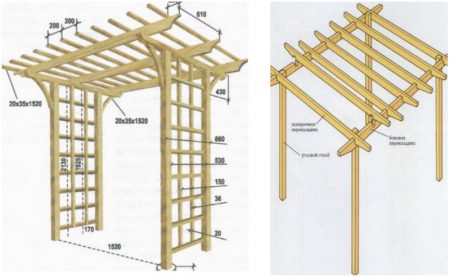
Tapestry mesh is a cheap and lightweight material that is resistant to ultraviolet and does not require additional storage costs. The only nuance here is that the mesh can sag due to the heaviness of the plant, so when choosing it, this nuance must be taken into account. Or then over time to replace the material with more durable.
When used as intended, working with a trellis mesh is pretty easy. For installation, it should simply be attached to the necessary hooks. To do this, first fasten one part of the mesh, fasten, pull and fix the other part. Moreover, this material is used not only for climbing roses, trellis mesh can be used for other crops, such as green peas or cucumbers.
Thanks to convenient material cells, it is easy for the plant to wrap them around.Also, it should be noted that tying or attaching to a trellis mesh is quite easy and not laborious. If necessary, it can be cut using a special tool.
Also, when growing climbing roses, plastic lattices are widely used. This material has a narrow weave, which allows air to circulate well.
Its additional advantage is that the plastic grill is lightweight and quite resistant to temperature changes, that is, it does not deform.
When using a plastic lattice, it is easiest to fasten with brackets, which first fix the top of the lattice, then stretch, align and fix the other half. You can use this material for growing not only roses, but also for other weaving plants. For example, ivy or girl's grapes.
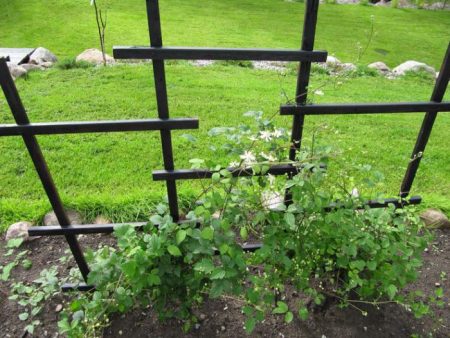
Often when growing climbing roses, they use steel wire, which can also be installed on their own, and this does not take much time, and by installing a steel frame, it can be used for a rather long period of time. First you need to fix the invented frame, and then you can create any form of support, which is more suitable or like it. After all, as you know, steel wire easily bends and cuts.
When making supports from steel wire, holes are first drilled in a selected rack at a certain distance. Then nails are inserted there. Then they attach the wire and twist it with the help of ticks. Then it is leveled and pulled, using special tongs as well. Then the end of the wire is pulled into a loop and also twisted. Tighten to the stop and check the design for strength.
Quite often, wooden lattices are used for supports of weaving roses, this material is the most common. Each host of the garden chooses the thickness of these lattices individually. Of course, you should not take thin beams for bulky crops, because with heavy weight they simply break. Usually correctly selected support lasts no more than 10 years.
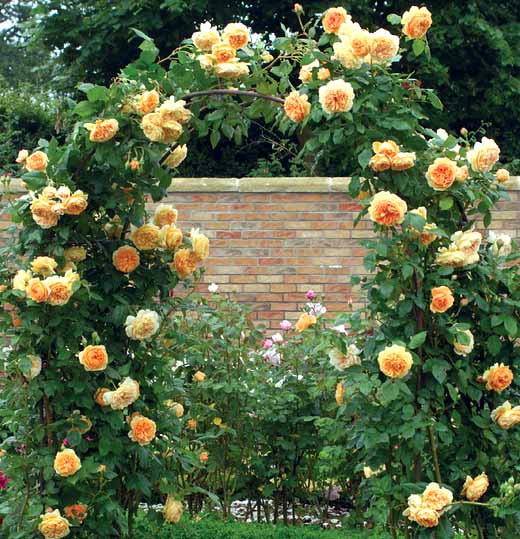
In order to make a wooden support, they independently select beams of the required thickness. Then with the help of a plumb level the level of the planned lattice. And only after that they are fixed to the wall or fence with screws. It must be borne in mind that wood is a material that is susceptible to decay. Based on this, often many gardeners before installation first process wooden beams with special protective equipment. This will maintain the durability of the support.
Undoubtedly, when choosing a suitable support for climbing roses, it is necessary to take into account not only the strength of the support, but also the aesthetic side. And, of course, when choosing for durability, many give their preference to metal structures. When installing them, the supports are often concreted. Such support will contribute to a long design life. Moreover, when the climbing rose has massive “vines” over time, they can lead to support deformation. Based on what, before designing, you should weigh and think through all the details of the installation and the permissible consequences.
It becomes very sad when the roses turn black after hibernation. We read about how to save them here.


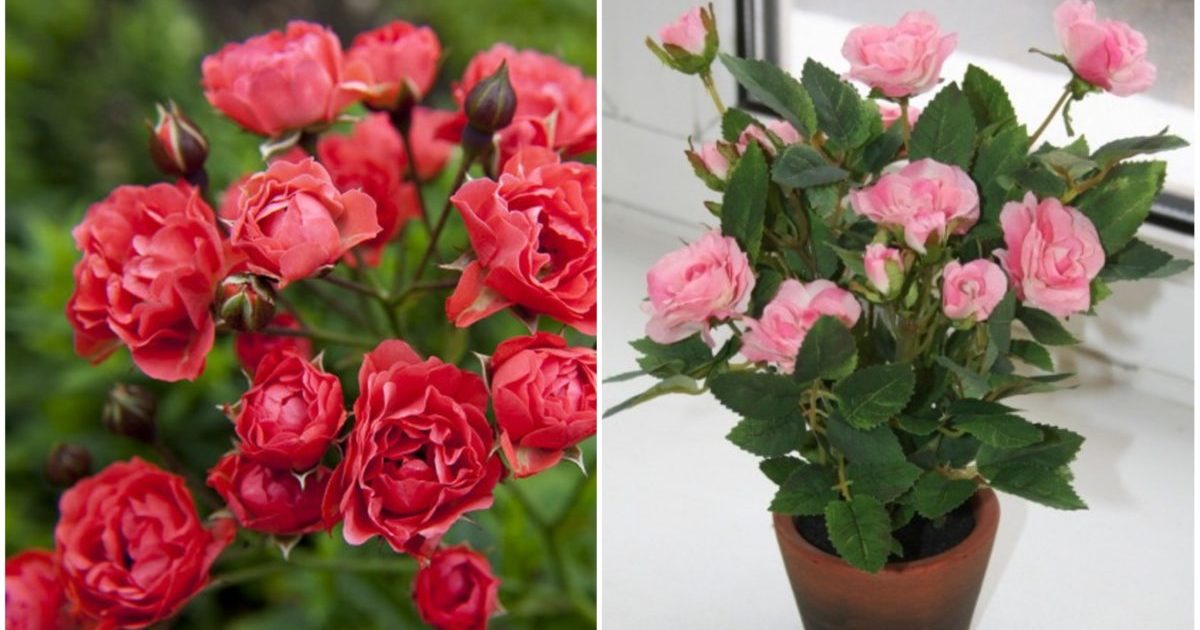

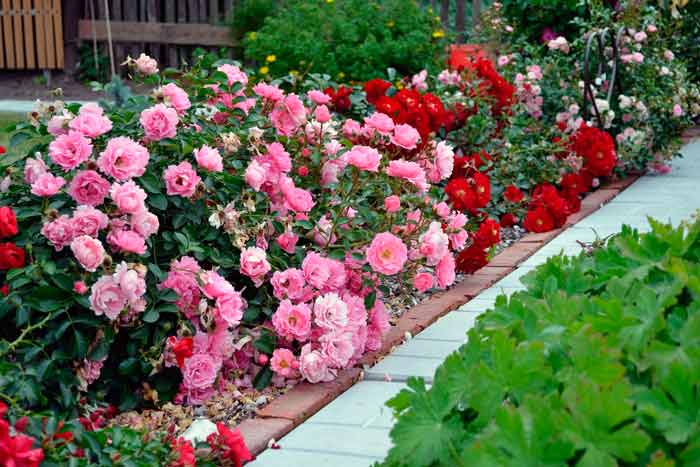 Shelter of roses for the winter: at what temperature does the robot hold
Shelter of roses for the winter: at what temperature does the robot hold How to prune roses in the fall: timing, pruning rules, pros and cons
How to prune roses in the fall: timing, pruning rules, pros and cons What are the varieties and types of roses
What are the varieties and types of roses How to process roses with iron sulfate in autumn: proportions, advantages and disadvantages
How to process roses with iron sulfate in autumn: proportions, advantages and disadvantages